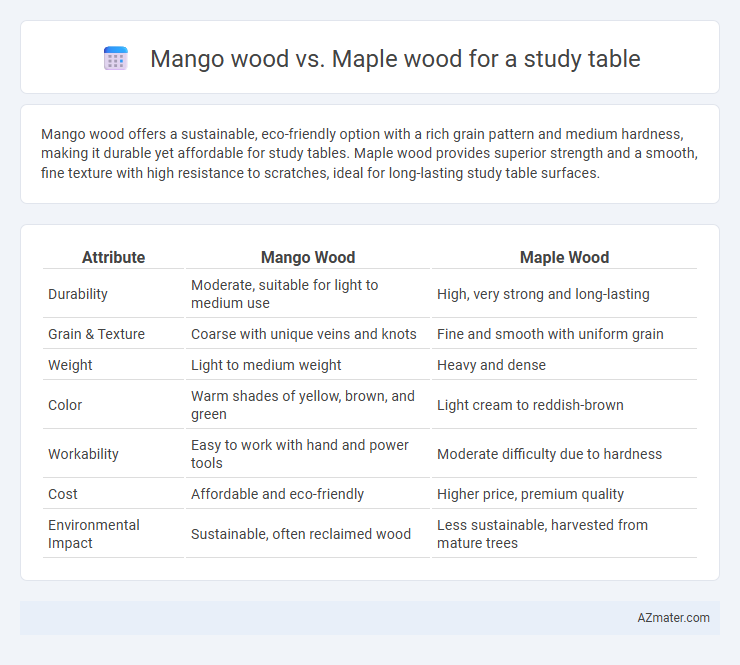Mango wood offers a sustainable, eco-friendly option with a rich grain pattern and medium hardness, making it durable yet affordable for study tables. Maple wood provides superior strength and a smooth, fine texture with high resistance to scratches, ideal for long-lasting study table surfaces.
Table of Comparison
| Attribute | Mango Wood | Maple Wood |
|---|---|---|
| Durability | Moderate, suitable for light to medium use | High, very strong and long-lasting |
| Grain & Texture | Coarse with unique veins and knots | Fine and smooth with uniform grain |
| Weight | Light to medium weight | Heavy and dense |
| Color | Warm shades of yellow, brown, and green | Light cream to reddish-brown |
| Workability | Easy to work with hand and power tools | Moderate difficulty due to hardness |
| Cost | Affordable and eco-friendly | Higher price, premium quality |
| Environmental Impact | Sustainable, often reclaimed wood | Less sustainable, harvested from mature trees |
Introduction: Mango Wood vs Maple Wood for Study Tables
Mango wood and maple wood are popular choices for study tables due to their durability and aesthetic appeal. Mango wood is a sustainable hardwood known for its unique grain patterns and resistance to warping, making it ideal for long-lasting furniture. Maple wood offers a smooth, consistent texture and high strength, providing a sturdy surface perfect for study environments.
Origin and Source of Mango and Maple Wood
Mango wood, primarily sourced from India and Southeast Asia, is harvested from the mango tree after it stops bearing fruit, making it a sustainable hardwood option for study tables. Maple wood originates mainly from North America and parts of Europe, derived from sugar maple and other maple species native to temperate forests; its dense grain provides durability and a smooth finish. Both woods offer distinct aesthetic and functional qualities influenced by their regional growing conditions and harvesting practices.
Appearance and Grain Patterns
Mango wood features a warm, golden-brown hue with rich, irregular grain patterns that create a rustic and inviting look for study tables. Maple wood offers a lighter, creamy color with smooth, consistent grain patterns that lend a clean, modern aesthetic. Both woods provide unique visual appeal, with mango wood emphasizing natural texture and maple showcasing subtle elegance.
Durability and Longevity Comparison
Mango wood offers moderate durability with a hardness rating of about 950 on the Janka scale, making it resistant to scratches and dents, while maple wood ranks higher at approximately 1450, providing superior strength and longevity for study tables. Maple's dense grain structure ensures enhanced resistance to wear and a longer lifespan under daily use, whereas mango wood, though eco-friendly and sustainable, may show signs of wear sooner. For a study table emphasizing durability and longevity, maple wood is generally the preferred choice due to its robust physical properties and endurance over time.
Workability and Ease of Crafting
Mango wood offers excellent workability with its medium hardness, making it easier to carve and shape for detailed study table designs compared to harder hardwoods. Maple wood is denser and more durable, which provides a smooth finish but requires sharper tools and more effort during crafting. Both woods are popular; mango wood is preferred for affordability and ease of crafting, while maple ensures longevity and a refined appearance for study tables.
Environmental Impact and Sustainability
Mango wood is considered a more sustainable option for study tables due to its fast growth cycle and use of wood from trees harvested after fruit production ends, minimizing deforestation. Maple wood, while durable and strong, typically comes from slower-growing hardwood trees, leading to higher environmental pressure and longer replenishment periods. Choosing mango wood supports reduced carbon footprint and promotes eco-friendly furniture production through responsible timber sourcing.
Cost and Affordability
Mango wood offers a cost-effective option for study tables, priced significantly lower than maple wood while maintaining good durability and aesthetic appeal. Maple wood, known for its strength and fine grain, commands a higher price, making it less affordable for budget-conscious buyers. Choosing mango wood maximizes affordability without compromising on quality, ideal for functional, stylish study tables.
Maintenance and Care Requirements
Mango wood offers moderate maintenance with its natural oils providing some resistance to moisture and scratches, requiring occasional polishing and cleaning with a damp cloth to maintain its durability and appearance. Maple wood demands more diligent care due to its lighter color and dense grain, often needing periodic sealing or finishing to prevent stains and moisture damage while regular dusting and wiping keeps the surface smooth. Both woods benefit from avoiding direct sunlight and using coasters, but maple generally requires more frequent treatments to preserve its polished look and structural integrity over time.
Suitability for Study Table Design
Mango wood offers durability and a unique grain pattern ideal for study tables with a rustic or artistic design, while maple wood provides a smoother, lighter finish suited for modern and minimalist study tables. Maple's hardness and resistance to scratches enhance its suitability for heavy use and long-term durability in study environments. Both woods support sturdy construction, but choice depends on the desired aesthetic and maintenance preferences for study table design.
Conclusion: Which Wood is Better for Your Study Table?
Mango wood offers a durable, eco-friendly option with unique grain patterns, making it a cost-effective choice for study tables that balance aesthetics and sustainability. Maple wood boasts superior hardness and smooth texture, providing long-lasting resistance to scratches and dents, ideal for a heavy-use study surface. Choosing between mango and maple wood hinges on prioritizing budget and visual warmth versus maximum durability and a refined finish for your study table.

Infographic: Mango wood vs Maple wood for Study Table
 azmater.com
azmater.com